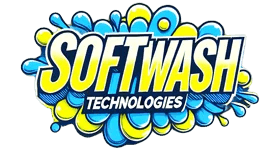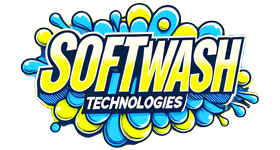FAQ
If you’re in the soft washing or pressure washing business, this FAQ section covers the questions we hear most from service providers like you. Whether you’re figuring out what setup to start with or troubleshooting equipment in the field, you’ll find quick answers and practical tips below!
Soft Washing
➤ What equipment do I need to start soft washing?
You’ll need a chemical-resistant pump system (like a 12V or gas-powered pump), at least one tank if you are batch mixing or two tanks if you are proportioning, a soft wash hose and gun. SH (sodium hypochlorite) combined with water to dilute to the required ratio will be your main cleaning agent, and a good surfactant helps it stick to surfaces and penetrate deeper for a better clean.
Safety should always come first. Wearing a respirator, and eye protection is important to avoid exposure while spraying.
For a full breakdown of the essential tools and why they matter, check out this blog: Essential Soft Washing Tools.
➤ What soft wash mix % should I use for different surfaces?
It depends on what you’re cleaning and how dirty it is.
• For delicate surfaces like vinyl siding, painted wood, or window frames, stick to a low mix around 1–2% SH.
• For tougher materials like brick, stucco, gutters, or concrete with moderate grime, go with 2–4%.
• Heavily stained areas like roofs, tile, or concrete with thick mold or algae may need a stronger mix, around 3–6% SH.
If you want a full guide on how SH works and how to mix it safely, check out this blog: Sodium Hypochlorite 101: Guide for Soft Washing Professionals
➤ Do I need a proportioner or can I batch mix?
You can batch mix when starting out, and it works fine. But a proportioner makes the job faster, more consistent, and saves you money in the long run by reducing waste and downtime.
If you’re thinking about building your own, check out our blog: How to Build a Soft Wash Proportioner
➤ What happens if you don’t rinse off sodium hypochlorite?
Sodium hypochlorite can keep reacting long after the job is done. This ongoing reaction can lead to discoloration, corrosion on metal surfaces, and damage to paint, siding, or roofing materials over time. Even if it looks done, the leftover chemical may still be active.
To stop this, a bleach neutralizer should be used during the post-rinse. After the proper dwell time, a neutralizer breaks down any remaining SH and helps bring the surface back to a safe, neutral state.
And if you want to learn more about how you can use bleach neutralizer to keep every job safe and damage-free, check out our blog: Bleach Neutralizer 101: Guide for Soft Wash Pros
➤ How often should I rinse my soft wash pump?
Your system should be rinsed with clean water after every job. This helps flush out any leftover SH from your pump, hoses, gun, and valves. When bleach sits too long, it can start eating away at your equipment. For an even deeper clean, rinse out your system with a bleach neutralizer regularly to maximize the life of your pump. Learn more here:
➤ What’s the better pump for soft washing: 12V or gas?
Choosing the right pump comes down to the kind of work you’re doing. A 12V pump works well for smaller residential jobs, especially if you’re just starting out. It’s affordable, easy to set up, and quiet.
For larger or more frequent jobs, a gas-powered pump might be the better choice. It delivers higher flow, handles longer runtimes, and is built to keep up with heavy use on big properties.
You can learn more about the pros and cons of both in our blog: 12V vs Gas Soft Wash Pumps
➤ Can I soft wash with a pressure washer?
Yes, but with some special equipment. Pressure washers are built for high pressure, while soft washing relies on low pressure and chemical application. Running strong SH directly through a pressure washing pump will corrode it very quickly since they’re not made to handle harsh chemicals.
However, with tools like the XJet M5 Nozzle, you can transform your pressure washer into a soft wash setup without sending bleach through the pump. The XJet uses a venturi system to pull chemical from an external container and sprays it at low pressure. It attaches to your pressure washing gun and bypasses any parts that would otherwise corrode.
This setup is ideal for beginners who want to get started without buying a full soft wash system. For a simple, affordable way to begin soft washing safely, check out our guide: Start Soft Washing for Under $200
➤ Why is my mix not working?
If your mix isn’t cleaning like it should, a few things could be going on. The SH might be too weak, especially if it’s old or has been sitting in the sun. Your mix ratio could also be off, or the surface might not be staying wet long enough for the chemical to do its job.
Another common issue is using the wrong surfactant or not enough of it. Without proper cling, your mix can run off too fast before it works. Check your ratios, your SH strength, and your dwell time to troubleshoot.
➤ How long should I let my mix dwell before rinsing?
Dwell time depends on what you’re cleaning and how strong your mix is. On average, 5 to 15 minutes is a good starting point. You’ll want to let the mix sit long enough to kill the organic growth, but not so long that it starts to corrode any non organic surfaces.
Watch for visual cues like when the mold or algae starts turning brown or disappearing, it’s usually ready to rinse. Try to keep the surface wet the whole time, and reapply if needed to keep the mix active.
➤ How do I prevent plant damage during a soft wash?
Before spraying, plants and surrounding soil should be fully soaked with water and preferably a neutralizer. This helps dilute and neutralize any runoff and creates a protective barrier. While working, it’s important to keep the plants wet and cover anything that’s especially sensitive.
After the job, a final rinse should be done, followed by a plant-safe neutralizer to break down any leftover chemical. These steps go a long way in keeping landscaping healthy and damage-free.
➤ Can I soft wash without SH?
Sodium hypochlorite (SH) is the main ingredient that actually kills mold, mildew, algae, and other organic growth during a soft wash. While surfactants help your mix cling to surfaces and improve coverage, they don’t have the cleaning power to remove growth on their own.
For those looking to avoid SH entirely, pressure washing is an option but it relies on higher PSI and more water to physically blast away grime. Even then, it can’t be used on delicate surfaces (asphalt shingles, vinyl siding, stucco, etc.) since the pressure may cause damage.
Soft washing always involves SH because it’s the only way to safely and effectively clean organic buildup without harming the surface.
Pressure Washing
➤ Can I pressure wash a roof?
No, roofs should not be cleaned with high pressure. Using a pressure washer can strip away granules, loosen shingles, force water under the roofing materials, and even void the manufacturer’s warranty.
Soft washing is the correct method. It uses low pressure and the right chemical mix to safely remove mold, algae, and stains without damaging the roof.
➤ What’s the right way to store a pressure washer?
When putting your pressure washer away, especially for the off-season, it’s important to protect both the engine and the pump. Start by draining any leftover fuel and running the engine until it shuts off. Always have water running through your pump to avoid over heating and internal damage. After the engine runs dry, detach the pump from water and give it 2 pulls on the starter handle to push out any residual water inside. This helps prevent internal corrosion, seal damage, and freeze-ups.
Store the unit in a cool, dry place where it’s safe from moisture and extreme temps.
➤ What’s the best way to prevent stripes or streaks?
To avoid stripes (also called tiger stripes) when pressure washing flat surfaces like concrete, follow these tips:
- Consider a surface cleaner: These attachments provide uniform cleaning and reduce streaking.
- Maintain a steady pace: Move the wand or surface cleaner slowly and evenly.
- Monitor tip hygiene: If one tip gets clogged your bar will spin slowly or not at all and push all the pressure through the open nozzle which can stripe a surface.
- Overlap each pass by 25–50%: This ensures consistent coverage.
- Use the correct nozzle: A 25° or 40° tip is ideal for even cleaning.
- Keep the nozzle at a consistent height: Uneven distances can cause streaks.
For a visual guide, check out this video.
➤ Why is my pressure washer losing pressure?
Loss of pressure is a common issue and can be caused by several things. One of the most frequent problems is a clogged spray nozzle, which restricts flow and should be cleaned or replaced. Air leaks in the inlet hose or fittings can also disrupt water pressure, so it’s important to check all connections for cracks or loose fittings. A clogged inlet filter may be blocking water flow, and that should be cleaned or swapped out regularly. If the unloader valve isn’t working correctly, it could be recycling too much water back into the pump instead of sending it to the spray gun. Internal pump issues, such as worn seals or valves, may also be to blame and will usually require professional servicing to fix.
➤ What size surface cleaner should I use with my machine?
The size of the surface cleaner depends somewhat on your pressure washer’s GPM (gallons per minute):
- 8+ GPM: 20″ and up
- 5-8 GPM: Opt for a 18″–20″
- 4 GPM: A 16″–20″ cleaner is suitable.
- 2–3 GPM: Use a 12″–15″ surface cleaner.
➤ Can I use a pressure washer to remove oil stains from concrete?
Yes, a pressure washer can help lift oil stains from concrete, but pressure alone usually isn’t enough. For best results, pre-treat the area with a degreaser or concrete cleaner designed for oil removal. Let the cleaner dwell for several minutes to break down the stain, then follow up with a high-pressure rinse using a surface cleaner or a narrow-angle nozzle. Keep in mind that older or deep-set stains may not come out completely without multiple treatments, and they can reappear over time if it is a deep stain.
➤ How often should I change my pressure washer pump oil?
Change the oil after the first 50 hours of use, then every 100 hours or once a season (whichever comes first). If you use your pressure washer frequently, change it more often to keep the pump running smoothly. Always use the oil type recommended by your pump’s manufacturer.
➤ How close should the spray tip be to the surface?
Your spray distance depends on what you’re cleaning. For solid surfaces like concrete or brick, getting as close as 6 to 12 inches is usually effective. For more fragile materials like siding, trim, or painted areas, it’s better to stay a few feet back and work your way in to avoid stripping or damage.
As a rule, start farther away and move in slowly until the pressure feels just right for the surface. The closer you go, the stronger the impact.

